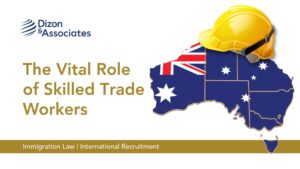Regional and rural areas across Australia continue to face real pressure when it comes to finding skilled workers. Unlike larger cities, local businesses in these communities often struggle to fill essential roles across a wide range of industries, as the standard work visa options aren’t always designed with regional needs in mind. The strict English language requirements, narrow occupation lists, and salary thresholds simply don’t reflect the local conditions, priorities or realities of these communities.
In 2015 a targeted solution was introduced – DAMA Agreements – Designated Area Migration Agreements. Yes, DAMAs have been around for longer than you would expect, changing and evolving over time, yet it still seems to fly under the radar.
Despite their importance, DAMAs remain relatively unknown. Increasing awareness and accessibility of these agreements can play a crucial role in strengthening regional economies and workforce sustainability.
What are Dama Agreements?
DAMAs are tailored migration agreements that allow specific regions within Australia to address local workforce gaps. They give employers more flexibility to sponsor skilled overseas workers for roles that can’t be filled locally, which in turn helps these communities to grow both economically and socially.
DAMA agreements make it easier for employers to access skilled workers by relaxing some of the usual visa requirements, a big help for regions that are struggling to fill roles.
It is important to note that DAMAs only apply to specific geographic areas within Australia. If your business is not located within a designated DAMA region, you won’t be able to access the agreement. Active DAMA Regions in Australia (as of May 2025)
Active DAMA Regions in Australia (as of May 2025)
Australia has 13 active Designated Area Migration Agreements, each tailored to address specific regional workforce needs:

- Adelaide City Technology and Innovation Advancement DAMA (SA)
- South Australian Regional Workforce DAMA (SA)
- Northern Territory DAMA (NT)
- Far North Queensland DAMA (QLD)
- Townsville DAMA (QLD)
- Orana DAMA (NSW)
- Goulburn Valley DAMA (VIC)
- Great South Coast DAMA (VIC)
- East Kimberley DAMA (WA)
- Pilbara DAMA (WA)
- Goldfields DAMA (WA)
- South West DAMA (WA)
- Western Australia DAMA (State-wide)
Individuals cannot directly access a DAMA. Individuals need to be sponsored:
- by an employer operating in a designated region, and
- for an occupation that is specified in the head agreement
Why Keep an Eye on DAMA Agreements?
DAMA agreements are set to play an even more important role in supporting regional and rural Australia. These agreements give local businesses the chance to fill skill gaps that standard visa pathways often cannot meet. As more awareness continues to grow, so will their impact. DAMAs represent a practical, long-term opportunity for regions to attract the skill they need, making it achievable and supportive of economic growth.
DAMA agreements are set to play an even more important role in supporting regional and rural Australia. These agreements give local businesses the chance to fill skill gaps that standard visa pathways often cannot meet. As more awareness continues to grow, so will their impact. DAMAs represent a practical, long-term opportunity for regions to attract the skill they need, making it achievable and supportive of economic growth.
For employers and skilled professionals alike, understanding how the DAMAs work and how they differ from traditional visa programs, opens the door for new possibilities and competitive advantages.
Why Aren’t DAMAs Better Know?
You’re not the only one asking…
Despite their clear benefits we have seen firsthand through our own regional roadshows and direct engagement in these communities that DAMA agreements are still one of the most underutilised migration options available to rural and regional Australia.
If you are not familiar with the system or have not heard about DAMAs before, you are not alone, and we are here to help.
Unlike more familiar migration pathways, DAMAs require a tailored approach, often involving additional steps for employers to access the agreements. With the right guidance, it’s a manageable and often straightforward process with significant benefits.
How DAMAs Help Regional Employers Fill Workforce Gaps
Here are three ways the DAMA agreements support these communities:
- Offering Concessions to Visa Requirements
Employers can benefit from relaxed criteria such as reduced English language levels, expanded age limits, and lower salary thresholds. These concessions are especially useful in regional settings, where standard visa requirements may be too rigid to meet local realities.
- Allowing Employers to Sponsor Overseas Workers for Roles Not Covered by Standard Pathways
DAMAs enable employers to sponsor skilled overseas workers in occupations that are not available under standard skilled visa programs. This is particularly helpful for hard-to-fill roles in sectors like aged care, transport, construction, and hospitality.
- Tailored to the Specific Needs of Each Region
Each agreement is negotiated between the Australian Government and a regional authority to reflect local industry priorities. Whether a region is experiencing shortages in agriculture, health, technology, or trades, the DAMA is designed to meet those needs directly.
DAMA agreements play a practical and important role in tackling labour shortages, keeping regional businesses running, and helping local communities thrive.
How do DAMAs Differ from Other Migration Pathways?
What makes DAMAs stand out is their flexibility and their focus on local workforce needs.
- Practical Concessions: DAMAs allow for flexibility in key areas like occupation lists, salary thresholds, and English language requirements. So, if you were not hitting the usual benchmarks before, then this could be the opportunity that changes that.
- Tailored to Workforce Needs: Every DAMA is negotiated to suit the workforce needs of a specific area (region). Whether it is agriculture in South Australia or hospitality in Northern Queensland, these agreements are built to target real skill shortages that affect local economies.
- Empowering regional employers: DAMAs are designed to support businesses in rural and less populated regions, where securing skilled workers is often more of a challenge.
Other skilled migration and sponsorship programs often follow stricter national rules, which don’t always reflect what it’s really like trying to hire in regional Australia.
How we can help at Dizon & Associates
We understand the critical role DAMAs play in supporting regional workforce needs. Our team brings deep experience in migration, international recruitment and compliance, providing tailored support to employers and skilled professionals navigating the DAMA process.
If you’re not sure where to start, or need help submitting your DAMA application, we are happy to guide you through it.
Reach out to find out if your business is in a DAMA region and what your next steps could look like.








